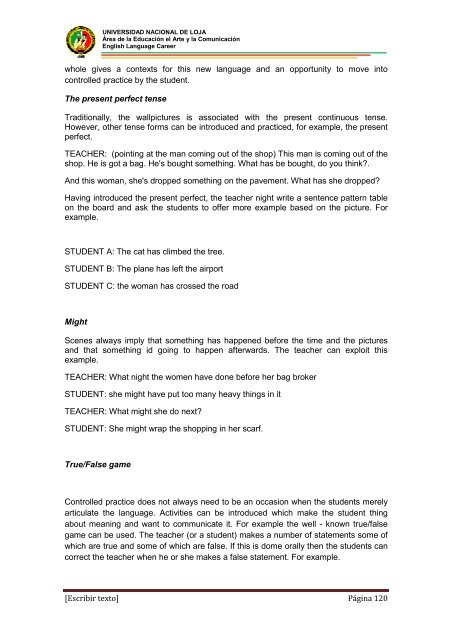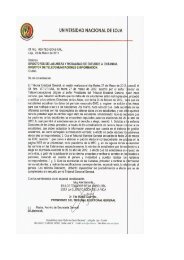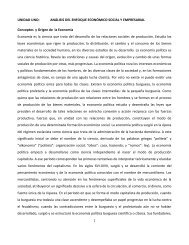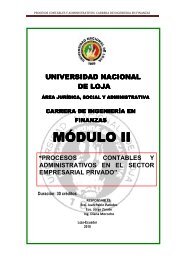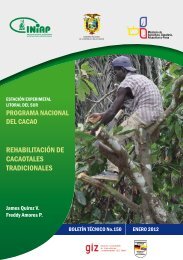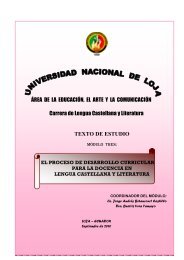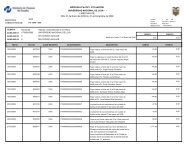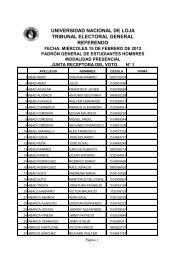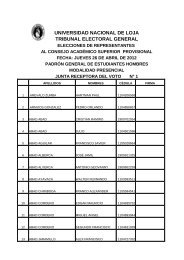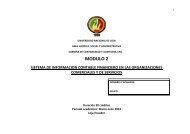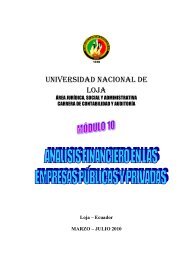module 5 planning of the english language teaching-learning process
module 5 planning of the english language teaching-learning process
module 5 planning of the english language teaching-learning process
You also want an ePaper? Increase the reach of your titles
YUMPU automatically turns print PDFs into web optimized ePapers that Google loves.
UNIVERSIDAD NACIONAL DE LOJA<br />
Área de la Educación el Arte y la Comunicación<br />
English Language Career<br />
whole gives a contexts for this new <strong>language</strong> and an opportunity to move into<br />
controlled practice by <strong>the</strong> student.<br />
The present perfect tense<br />
Traditionally, <strong>the</strong> wallpictures is associated with <strong>the</strong> present continuous tense.<br />
However, o<strong>the</strong>r tense forms can be introduced and practiced, for example, <strong>the</strong> present<br />
perfect.<br />
TEACHER: (pointing at <strong>the</strong> man coming out <strong>of</strong> <strong>the</strong> shop) This man is coming out <strong>of</strong> <strong>the</strong><br />
shop. He is got a bag. He's bought something. What has be bought, do you think?.<br />
And this woman, she's dropped something on <strong>the</strong> pavement. What has she dropped?<br />
Having introduced <strong>the</strong> present perfect, <strong>the</strong> teacher night write a sentence pattern table<br />
on <strong>the</strong> board and ask <strong>the</strong> students to <strong>of</strong>fer more example based on <strong>the</strong> picture. For<br />
example.<br />
STUDENT A: The cat has climbed <strong>the</strong> tree.<br />
STUDENT B: The plane has left <strong>the</strong> airport<br />
STUDENT C: <strong>the</strong> woman has crossed <strong>the</strong> road<br />
Might<br />
Scenes always imply that something has happened before <strong>the</strong> time and <strong>the</strong> pictures<br />
and that something id going to happen afterwards. The teacher can exploit this<br />
example.<br />
TEACHER: What night <strong>the</strong> women have done before her bag broker<br />
STUDENT: she might have put too many heavy things in it<br />
TEACHER: What might she do next?<br />
STUDENT: She might wrap <strong>the</strong> shopping in her scarf.<br />
True/False game<br />
Controlled practice does not always need to be an occasion when <strong>the</strong> students merely<br />
articulate <strong>the</strong> <strong>language</strong>. Activities can be introduced which make <strong>the</strong> student thing<br />
about meaning and want to communicate it. For example <strong>the</strong> well - known true/false<br />
game can be used. The teacher (or a student) makes a number <strong>of</strong> statements some <strong>of</strong><br />
which are true and some <strong>of</strong> which are false. If this is dome orally <strong>the</strong>n <strong>the</strong> students can<br />
correct <strong>the</strong> teacher when he or she makes a false statement. For example.<br />
[Escribir texto] Página 120


